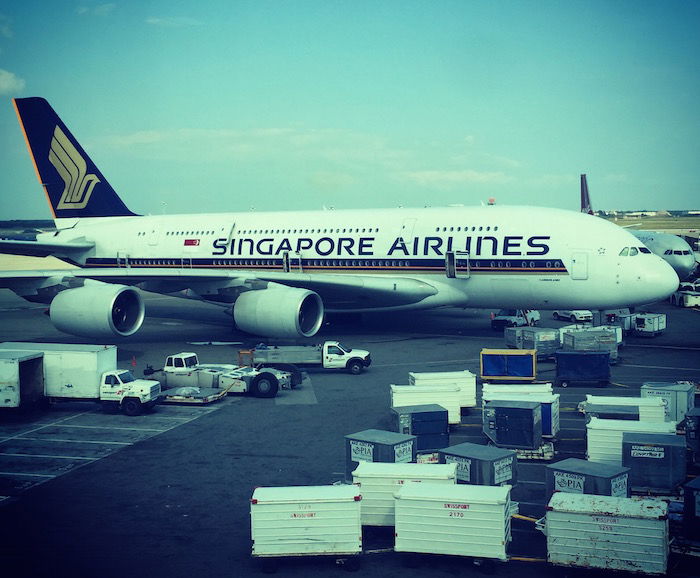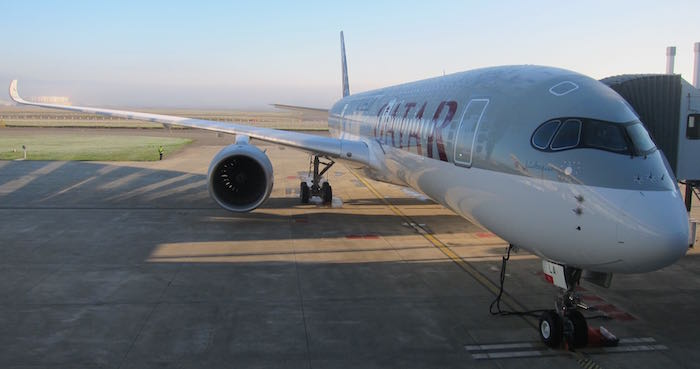Emirates is by far the world’s largest A380 operator. There have been a total of 317 A380 orders, and 142 of those are from Emirates. Emirates has nearly as many A380s on order as all other airlines combined.

While other airlines haven’t been terribly excited about the A380, Emirates has been able to make the plane work really well for them. They’ve managed to scale their route network enough so that operating several of these per day to New York, London, Sydney, etc., is viable.
However, there’s no denying that Gulf carriers are in trouble, and it goes beyond the situation with Qatar, and also beyond the recent electronics ban.
As oil prices have fallen, the Gulf carriers have struggled for a variety of reasons. One of those is that these airlines are government owned, and obviously the Gulf governments are in much better financial situations when oil prices are high. However, beyond that, there’s arguably also more high yield traffic to the region when oil prices are high.
The past couple of years we’ve seen significant cost cutting at Emirates. The airline even recently fired many of their flight attendant trainers, which tells you a lot about their outlook. Beyond that, late last year we learned that Emirates is deferring delivery of at least a dozen A380s by a year.
Despite all this, Bloomberg is reporting that Emirates is in talks with Airbus to buy a further 20 A380s, which they could take delivery of as early as 2020. Per the story:
Emirates, the biggest operator of Airbus SE’s A380 superjumbo, is in talks about the purchase of 20 more of the double-decker jets in a move that could extend the lifespan of a program dogged by slow sales, people familiar with the discussions said.
The contract would be worth $8.7 billion before discounts, though negotiations are at an early stage and it hasn’t been established exactly how many aircraft the Persian Gulf carrier requires, according to the people, who asked not to be named because the talks are private. Airbus might also be required to commit to measures to make the A380 more efficient before a deal is signed.
Rumor has is that Emirates wouldn’t be ordering further A380s for the purposes of increasing the size of their fleet (they already have 218 planes on order), but rather in order to replace some of the A380s that they’re presently leasing.
Emirates has been operating the A380 since 2008, and many of their planes have leases that are up for renewal soon. I’m a bit surprised that Emirates would return some of these A380s to their lessor and buy new ones, rather than just extending the leases, where I imagine they’d get attractive deals.
However, with the way financing with many of these deals works, maybe picking up new A380s wouldn’t be as expensive as you’d think. If that does happen, the number of A380s on the second hand market will continue to grow, as Singapore Airlines is also about to return five A380s to their lessor.

Bottom line
I’ll be curious to see if this further A380 order comes to fruition, which would keep A380 production alive for a couple more years. As I’ve always said, unfortunately the A380 was introduced a bit too early. With the pace at which global air travel is growing, and with worsening congestion at major global hubs, I think the A380 would’ve been really successful in a decade or two. However, for the time being, airlines are much more excited about the A350 and 787.

If Emirates does in fact order these planes, I imagine they’ll be intended to replace their existing leased A380s. If so, we’ll see an even bigger second hand A380 market. Given how attractive used A380 prices will likely be, I wonder if any airline will be encouraged to pick up these planes.
It’s not often you see an airline both deferring delivery of and ordering more of a particular plane…





Slots, slots peak hour slots st most major airports ate full or horrendously expensive. Thats why QF PER-LHR arrives mid afternoon with a greatly reduced premium cabin size due yo the lack of demand from premium passengers for the timetable. Some of us arrive in LHR @ 6am ish and teturn that night to Australia yeah it's hell but you can only do it at the pointy end.
@ SVA Liver really what are you...
Slots, slots peak hour slots st most major airports ate full or horrendously expensive. Thats why QF PER-LHR arrives mid afternoon with a greatly reduced premium cabin size due yo the lack of demand from premium passengers for the timetable. Some of us arrive in LHR @ 6am ish and teturn that night to Australia yeah it's hell but you can only do it at the pointy end.
@ SVA Liver really what are you doing on an aviation blog. Boeing to a lessor extended Airbus got the saftey range changed for the twin engine aircraft changed. Should 1 or 2 accidents occur then you ste going ti see a lot less tein engines everywhere. Four engines can take short cuts that twins can't.
Just like range if QF could get another 1500 ks out of a plane, the route SYD-LHR is very very different to todays route.
I think these planes are refered to as hub destroyers just possible know with all premium configurations.
New first class cabin coming up combined with how often Emirates upgrades their ICE system: I can see why they wouldn't care to keep the old cabins. By 2020 the new planes would just come in with the new first class rather than justifying a costly expense of retrofitting the older planes: Emirates prefers to also keep a newer fleet. Also we don't know what the product actually looks like so we don't know how difficult the retrofit would be.
Hey Lucky how is it going, can you please answer this asap if you can?
Which route did you pick for your Saudia flight from USA to KSA?
(LAX - JED), (IAD - JED), (IAD - RUH) or (JFK - RUH)?
Seriously when the heck will the era of 4 engine aircraft end..
@lucky - I forgot to conclude... It won't take very long for routes needing more than 360pax due to slot constrained airports to demand an aircraft like the A380. Over 95% of the worlds international airports do not have the capacity to add another runway. The US has only 3 airports that can do so DFW, ORD and ATL for example.
Cheers,
Chris aka jetsetkid
Remember that the A388 was never the original intended size build when designed. If you clean up the aerodynamics, add the newly introduced galley/staircase changes to increase the seat capacity by 40 Y seats, and then you add the 7m plug for the original size for a A389 AND then add (as Jim Clark has always requested,) GTF engines to this aeroplane, you would then have an aircraft that would have a seat cost reduction...
Remember that the A388 was never the original intended size build when designed. If you clean up the aerodynamics, add the newly introduced galley/staircase changes to increase the seat capacity by 40 Y seats, and then you add the 7m plug for the original size for a A389 AND then add (as Jim Clark has always requested,) GTF engines to this aeroplane, you would then have an aircraft that would have a seat cost reduction of approx 30-34% less than the current A388. Bringing to an average of less than 2L/100km per pax. The economics would literally crush every other long haul aircraft out of the market. In a regular 4 class cabin offering with all the above points on a new purchase you are looking at a 420pax aircraft which would go up to 500pax for an A389.
So then what are the new A350/B787 for???
Well, they are both just consolidating two previous categories of aircraft for medium haul requirements. They are neither cannibalising or opening new markets. The B767/777 as well as the A330/340 were for the most part never used to their maximum range capabilities by their respective fleet owners. The A350/B787 series of aeroplanes are basically right sizing to the market needs in addition to providing organic growth for users of the B767 who needed just a bit more seat capacity. Even with possible stretches of the A350/B787 occurring in the near future they will still be seat limited with a range of 250-350 between all versions of these families. This is due to the increased demand for square footage for both the premium and ever growing PE cabins. As an example neither QR or SQ even come close to 300 pax on their A359s (A350-900) which officially are meant to seat 325 pax. The new B779X will still only give us that extra seat growth to allow @360 pax max. (taking into current seat layouts and designs) with a bit further distance capacity. But this is its max capability until a GTF is available for further range only (its dimensions are already at max allowed by international regulations).
Chances are it relates to the change in accounting rules (IFRS). The tax benefits under currect rules are eroded under new rules coming in 2018. It's better to just buy as Capex rather than lease.
Granted I'm not sure in how far Dubai GAAP follows IFRS.
Since you are one to pick up on the most minor of details (in a good way! ) I must tell you that the correct term is 'Lessor' not 'Leaser'
@ Aaron -- Good catch!
A lot of the most heavily congested airports are congested because they are connecting hubs--in addition to O/D locales. Opening up more point to point service alleviates the hub congestion to the point where the need for a superjumbo may never actually materialize. If airlines can earn a revenue premium flying smaller, less expensive, more fuel efficient aircraft on these secondary routes, why wouldn't they?
Obviously that isn't true for a carrier like Emirates...
A lot of the most heavily congested airports are congested because they are connecting hubs--in addition to O/D locales. Opening up more point to point service alleviates the hub congestion to the point where the need for a superjumbo may never actually materialize. If airlines can earn a revenue premium flying smaller, less expensive, more fuel efficient aircraft on these secondary routes, why wouldn't they?
Obviously that isn't true for a carrier like Emirates or Qatar which are connecting hubs much more so than destinations in their own right, but most places like that are also 24 hour airports which itself obviously alleviates lots of congestion.
Maybe Emirates wants to keep that fleet shiny and new, and other carriers will consider buying used ones. Corsair should do all all economy party bus A380 from Paris to St. Maarten
I'd imagine that the difference between maintenance costs of a new aircraft and a 10-year old aircraft is justifiable enough that they are ready to pay a bit more leasing costs for a new aircraft than extending the existing ones at a cheaper rate.
Just a conjecture on my part.
i love how you've added a QR plane in the end just to subtly add fuel to the Riyadh-Doha spat *popcorn*